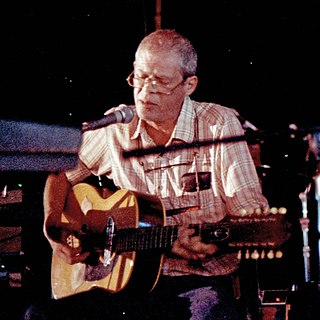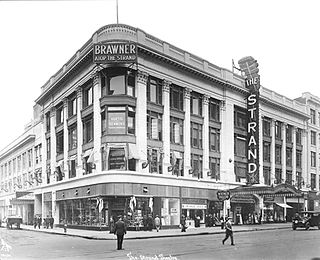
Ralph Rapson was Head of the School of Architecture at the University of Minnesota for 30 years. He was an interdisciplinary designer, one of the world's oldest practicing architects at his death at age 93, and also one of the most prolific. His oldest son is the philanthropist Rip Rapson.

The Walker Art Center is a multidisciplinary contemporary art center in the Lowry Hill neighborhood of Minneapolis, Minnesota, United States. The Walker is one of the most-visited modern and contemporary art museums in the U.S.: together with the adjacent Minneapolis Sculpture Garden and Cowles Conservatory, it has an annual attendance of around 700,000 visitors. The museum's permanent collection includes over 13,000 modern and contemporary art pieces, including books, costumes, drawings, media works, paintings, photography, prints, and sculpture.

The University of St. Thomas is a private Catholic research university with campuses in St. Paul and Minneapolis, Minnesota. Founded in 1885 as a Catholic seminary, it is named after Thomas Aquinas, the medieval Catholic theologian and philosopher who is the patron saint of students. As of fall 2021, St. Thomas enrolled 9,347 students, making it Minnesota's largest private, nonprofit university.

The Minneapolis Sculpture Garden is an 11-acre (4.5 ha) park in Minneapolis, Minnesota, in the United States. It is located near the Walker Art Center, which operates it in coordination with the Minneapolis Park and Recreation Board. It reopened June 10, 2017, after a reconstruction that resulted with the Walker and Sculpture Garden being unified as one 19-acre campus. It is one of the largest urban sculpture gardens in the country, with 40 permanent art installations and several other temporary pieces that are moved in and out periodically.

"Spider" John Koerner was an American guitarist, singer, and songwriter. He was best known as a guitarist and vocalist in the blues trio Koerner, Ray & Glover, with Dave Ray and Tony Glover. He also made albums as a solo performer and with Willie Murphy, and was an important mentor to the young Bob Dylan.

Saint Anthony Main is an stretch of buildings on Main Street across from Saint Anthony Falls in the Marcy-Holmes and Nicollet Island/East Bank neighborhoods of Minneapolis. The area is part of Southeast, Minneapolis, as it was originally the Main Street through the township of St. Anthony, Minnesota prior to most of that township's annexation in 1872. It opened as a festival marketplace in the 1980s.

The Uptown Theatre is one of the oldest surviving theaters in the Twin Cities area. It was in active use from 1916 to 2020. The theater reopened on June 10, 2023 as a music and event venue.

In the Heart of the Beast Puppet and Mask Theatre is an American puppet company and nonprofit organization based in Minneapolis, Minnesota. The theatre serves audiences through puppetry performance and education. The company has written and performed scores of full-length puppet plays, performed throughout the United States, Canada, Korea, and Haiti and toured the Mississippi River from end to end. The theatre historically sponsored the annual May Day Parade and Ceremony that was seen by as many as 50,000 people each year.

The Strand Theatre was an early movie palace located at 1579 Broadway, at the northwest corner of 47th Street and Broadway in Times Square, New York City. Opened in 1914, the theater was later known as the Mark Strand Theatre, the Warner Theatre, and the Cinerama Theatre. It closed as the RKO Warner Twin Theatre, and was demolished in 1987.

The Unique Theater was an 830-seat vaudeville theater, built in 1904 on Hennepin Avenue in downtown Minneapolis, Minnesota. It was built in the Renaissance Revival style, and situated between the Hennepin Center for the Arts and the West Hotel.
The .EDU Film Festival is Minnesota's only school-sponsored, statewide, high school film festival. The two-day event puts Minnesota's young filmmakers together with film industry professionals and provides them with an authentic festival experience. The festival features student film screenings, equipment demos; roundtables with film directors, writers, and producers; and meet-and-greets with post secondary institutions that feature strong film/video production programs.

Into Temptation is a 2009 independent drama film written and directed by Patrick Coyle, and starring Jeremy Sisto, Kristin Chenoweth, Brian Baumgartner, Bruce A. Young and Amy Matthews. It tells the story of a sex worker (Chenoweth) who confesses to a Catholic priest (Sisto) that she plans to kill herself on her birthday. The priest attempts to find and save her, and in doing so he plunges himself into a darker side of society.

Southtown Center, colloquially known as Southtown, is a regional shopping mall in Bloomington, Minnesota, a suburb of the Twin Cities. Southtown Center consists of 534,650 square feet (50,000 m2) of retail space. The center contains 38 retail tenants and is anchored by AMF Bowling Centers, Kohl's, and TJ Maxx.

The Hollywood Theater is a historic theater building in Minneapolis which is listed on the U.S. National Register of Historic Places. It is located in the Audubon Park neighborhood of Minneapolis.

The Riverview Theater is a cinema in the Howe neighborhood of Minneapolis, Minnesota, United States. Designed by Liebenberg and Kaplan, the theater was built by theater owners Bill and Sidney Volk in 1948. After building a subsequent theater in a new ultramodern style, the Volks returned to the Riverview in 1956 and had its lobby area heavily renovated and updated. The Riverview remains one of several surviving single-screen cinemas in the Minneapolis–Saint Paul area and typically showed second-run films until the COVID-19 pandemic, when it switched to showing first-run movies. Since the early 2000s, it has been consistently recognized by City Pages as one of the best movie theaters in the area.

The Public Domain is a 2015 drama film set in Minneapolis, Minnesota. The film follows characters whose lives were impacted by the collapse of the I-35W Mississippi River bridge on August 1, 2007. The story takes place seven years later. It is centered in a bar in a Polish neighborhood named The Public Domain. The time is around the feast of Saint Casimir

The Terrace Theatre was located at 3508 France Avenue North in Robbinsdale, Minnesota. Upon its opening on May 23, 1951, the Terrace received critical acclaim for its “bold architectural lines [and] extensive patron services.” The 1,299-seat theater, designed in the mid-century modern style by the Minneapolis architectural firm of Liebenberg & Kaplan (L&K) for movie exhibitors Sidney and William Volk, was a popular Twin Cities destination for nearly fifty years. It changed hands in 1980 and again in 1987, when it was remodeled from a single-screen auditorium into three screens by dividing the balcony. The last movie was screened in 1999 and the theater remained boarded up for seventeen years before it was demolished in the fall of 2016 to be replaced by a Hy-Vee grocery store.

The Trylon Cinema is a 90-seat movie theater in the Longfellow neighborhood of Minneapolis, Minnesota. The cinema was founded and is currently run by Take-Up Productions, a group of volunteers who got their start at the Oak Street Cinema before establishing the Trylon in 2009 within a former warehouse. A 2017 expansion resulted in an increase in the cinema's seating capacity and accessibility. Throughout its history, the venue has featured a variety of regular programming, ranging from career retrospectives of famous directors to B movies and cult films. The Trylon has been well received by critics who have praised its film lineup, intimacy, and atmosphere.
Liebenberg and Kaplan (L&K) was a Minneapolis architectural firm founded in 1923 by Jacob J. Liebenberg and Seeman I. Kaplan. Over a fifty-year period, L&K became one of the Twin Cities' most successful architectural firms, best known for designing/redesigning movie theaters. The firm also designed hospitals, places of worship, commercial and institutional buildings, country clubs, prestigious homes, radio and television stations, hotels, and apartment buildings. After designing Temple Israel and the Granada Theater in Minneapolis, the firm began specializing in acoustics and theater design and went on to plan the construction and/or renovation of more than 200 movie houses throughout Minnesota, North and South Dakota, Iowa, and Wisconsin. Architectural records, original drawings, and plans for some 2,500 Liebenberg and Kaplan projects are available for public use at the Northwest Architectural Archives.


















